Pondering Cuero’s Chupacabras
Posted by: Loren Coleman on September 1st, 2007
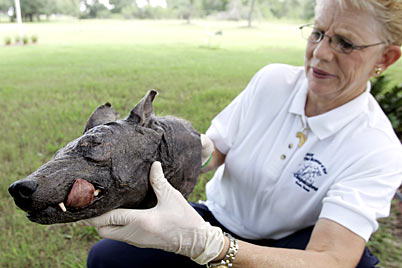
Phylis Canion and her dead head are all over the internet and the media today. Is it a Chupacabras? The answer may rest soon in a lab in Maine.
Perhaps Ms. Canion will read this or someone in authority in Texas shall – and they will contact me. I was telephoned tonight by Dr. Irv Kornfield, Professor of Biology and Molecular Forensics, at the University of Maine, who was helpful in running the DNA samples on last summer’s “Maine Mutant” carcass. Dr. Kornfield has volunteered to run DNA tests on this new Cuero specimen, and I shall be attempting to obtain a sample for him. Ms. Canion, your phone is busy. Please contact me via editor@Cryptomundo.com to get your DNA tests done. No shipping costs to you.
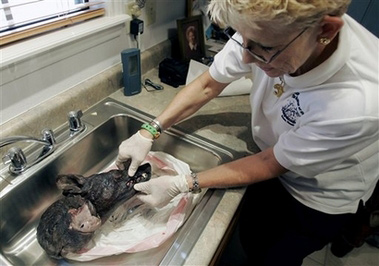
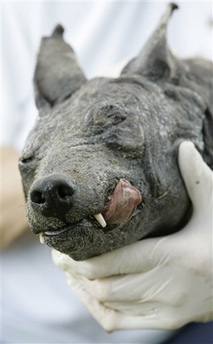
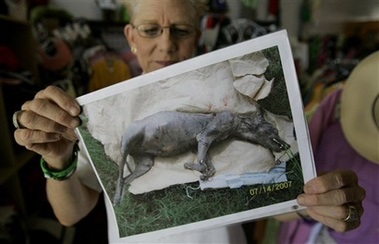
No two ways about it. There’s lots of interest being generated by the new photographs above (all by Eric Gay) added to a recent two-month-old story, renewed, of Phylis Canion’s “Chupacabras” of Cuero, DeWitt County, Texas.
As you may recall, in July 2007, the pictured animal (see directly below) was hit by a car and killed on Phylis Canion’s property, on Buenger Road off U.S. Highway 183 south of Cuero, Texas. Canion had said she saw this “animal” for two years roaming her property.

(Phylis Canion/Contributed Photo)
As Craig Woolheater and I mentioned at the time, the original photographs strongly resembled the Elmendorf Beast. See photographs of the Elmendorf carcass below.


In May, 2004, Elmendorf, Texas farmer, Devin McAnally, shot an animal that was eating berries on his property, and he thought it might be the creature that had been bothering his chickens. Photographs of the hairless, gray, weathered carcass circulated on the internet as a possible Chupacabras. Examination of the remains and the photographs clearly showed that the animal was a canid, suffering with sarcoptic mange caused by scabies. The Sarcoptes scabiei (variety canis) mites burrow and lay eggs under the skin of the animals, with massive hair loss spreading to the entire body.
So what was the “new” 2007 Chupacabras of Phylis Canion’s? DNA tests were to be run at Texas A&M in July. What were the results?
Was this the storied Chupacabras? Or another coyote, fox, or dog with mange?

I had seen one three or four times on our place, but it’s very elusive. So, when I got the call that one had been killed, I got it and took it back to the house. It’s a strange-looking animal. It has short front legs and longer back legs. The paws on the front are different than the ones on the back, and it has no hair. The nose is very long. The tip of the nose is longer than the lower jaw, and the front teeth stick out, almost like fangs.
They are the ugliest things I have ever seen in my life. I don’t know if it was related or not, so I began to set a chicken out at night.
I would find the chicken the next day with all the blood drained out. The carcass was left behind. The scariest thing that happened was the day I found the chicken on my back porch. All the blood was sucked out, and there was not one drop of blood on my porch.
Others I have talked to have seen it, too. But they didn’t tell anyone because they were afraid people would think they are crazy.Phylis Canion, July, 2007.
Now on September 1, 2007, this new Associated Press dispatch about the story, with Canion holding the animal’s head, has zoomed around the world. I’ve been contacted by people I haven’t heard from since I was in graduate school (including a Dean) and many, many others asking me if I’ve seen the article.
For some reason if you google Chupacabras, oftentimes you come up with Coleman too. 🙂 [Part of the joke here is that Coleman, Texas, has infrequently been linked to these “found” mysterious gray Chupa-canid carcasses as well as your humble Cryptomundo cryptozoologist.]
Of course, I couldn’t miss the article and I watched it spread. Written by Elizabeth White with those compelling photographs (up top) by Eric Gay, the piece has everyone talking about Chupacabras again.
The article says little that is new to the story since July, but firmly quotes the owner of the carcass as saying “Canion believes she may have the head of the mythical, bloodsucking chupacabra.”
It furthermore quotes Canion as saying the animal may have killed as many as 26 of her chickens in the past couple of years.
One thing is for certain, writer White is correct to say this Chupacabras has “captured the imagination of locals, just like purported sightings of Bigfoot or the Loch Ness Monster have elsewhere….[for] the discovery has spawned a local and international craze. Canion has started selling T-shirts that read: ‘2007, The Summer of the Chupacabra, Cuero, Texas,’ accompanied by a caricature of the creature. The $5 shirts have gone all over the world, including Japan, Australia and Brunei.”
If everyone has a fun time with it, we’ll keep doing it. It’s good for Cuero.Phylis Canion, quoted by the AP on September 1, 2007.
So contact me, Ms. Canion, and I’ll get your sample tested for DNA, free, at one of the best labs in the world for such analyses. The testing is done openmindedly, with strict scientific rigor.

[Footnote: Unfortunately the AP’s Elizabeth White used incorrect terminology once again, employing the improper Anglo-singular “Chupacabra,” instead of the proper Spanish “Chupacabras” for both single and multiple animals.]
About Loren Coleman
Loren Coleman is one of the world’s leading cryptozoologists, some say “the” leading living cryptozoologist. Certainly, he is acknowledged as the current living American researcher and writer who has most popularized cryptozoology in the late 20th and early 21st centuries.
Starting his fieldwork and investigations in 1960, after traveling and trekking extensively in pursuit of cryptozoological mysteries, Coleman began writing to share his experiences in 1969. An honorary member of Ivan T. Sanderson’s Society for the Investigation of the Unexplained in the 1970s, Coleman has been bestowed with similar honorary memberships of the North Idaho College Cryptozoology Club in 1983, and in subsequent years, that of the British Columbia Scientific Cryptozoology Club, CryptoSafari International, and other international organizations. He was also a Life Member and Benefactor of the International Society of Cryptozoology (now-defunct).
Loren Coleman’s daily blog, as a member of the Cryptomundo Team, served as an ongoing avenue of communication for the ever-growing body of cryptozoo news from 2005 through 2013. He returned as an infrequent contributor beginning Halloween week of 2015.
Coleman is the founder in 2003, and current director of the International Cryptozoology Museum in Portland, Maine.






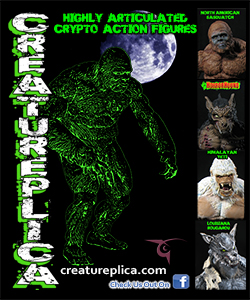



LOL I noticed the mis-spelling immediately and thought of this blog.
At least the lady in question is being sensible about this, she thinks it MAY be a Chupacabras but she also happens to think that the Chupies are a (as yet unidentified) type of dog breed.
I believe the USA Today article mentioned that she hunted big game in Africa too. I suppose that would make her a bit calmer in examining an unknown animal.
BTW, would freezing the head cause damage to the tissue samples? (for the purpose of DNA extraction and examination)
As noted by the illustration shown of a “Chupa”, and hearing and reading other eyewitness accounts, I dont think that I ever remember it being described as having a canine type head/snout or having a canine body profile. Mrs. Canion may have something new, but I dont think its a chupacabras.
I do believe freezing something does make dna harder to read accurately. I dunno. Something about a chupie being a dog just doesn’t sit with me. It will be interesting to find out. By the way, if chupies are a breed of dog, especially a known breed, then how will we know if this is one?
Didn’t one of the news stories (the AP one) mention that Ms Canion and her neighbors initially spotted *three* carcasses over several days in July?
One animal is a freak, but three is a population.
If true, is sarcoptic mange contagious?
Freezing the head should not degrade the DNA enough to prevent it from being read and compared to known animals.
I believe it is yet another canine with mange or a hairless canine.
It’s pretty obvious to me that this is likely a Mexican Hairless dog (or at least part Mexican Hairless).
http://en.wikipedia.org/wiki/Mexican_Hairless_Dog
As a RVT, I can tell you that yes, Sarcoptic Mange is quite contagious and very common amongst feral dogs who typically have stressed immune systems. For three in a given area to have it would be completely within the realm of reason.
Frozen or not, a very simple test can be done to a small section of that animal’s skin and would reveal the mites, confirming or refuting the scabies ridden dog theory. However, allergic conditions in dogs can cause atopy, where the skin darkens and the hair falls out as well. In short, there’s several things that can make a dog look like that, and my money will be on that being an ordinary dog. I’ve seen many a completely hairless dog and there is nothing there that I can’t nail down as really that unusual looking. Remember, domestic dogs are the most diverse single species on this planet.
hey loren very informative new article about chupecabra, i realy like everyone above replys regarding this chupercabra story as well. thanks bill green 🙂
I don’t think any of these aminals were reported to be walking upright.I don’t see any spikey protrusions as noted in the original illistration.Lets PLEASE bury the dead dogs and look for the real deal!
Could it be a form of canid polycythemia?
Yep. It’s a dog. No doubt about it. And that looks like a runaway case of sarcoptic mange mites for sure.
Sarcops is a seasonal problem in areas with really cold winters, because feral dogs (or other animals for that matter) with such a widespread infestation simply do not survive a really cold winter without their fur. But in areas with more moderate winters, mange is a year-round problem, and it is extremely contagious, especially among social animals like canines. Barring secondary infections, it’s usually survivable (although it undoubtedly makes for a miserable existence, since the little buggers cause a devil of an itch).
Poor dog reminds me of Duece, the now-gorgeous GSD I rescued several years ago. He was feral and had just about as much hair as that disembodied canine head in the photo above. If I hadn’t lived and breathed Shepherds all my life I would not even have recognized him as one of the breed. But after a couple of injections of ivermectin and a liberal slathering of good ole Happy Jack Mange Medicine, and a lot of TLC, he is now a beautiful, healthy elderly gentleman of a German Shepherd Dog alive and well in sunny Florida, with a full coat of fur in glorious black and gold.
This poor critter could probably have been saved and rehabilitated too. I don’t see any mystery here, except : why are human beings so quick to jump to outrageous conclusions, when a perfectly reasonable explanation is right in front of them?
If this turns out to be a regular canine, with or without mange, what do we make of her claim that “would find the chicken the next day with all the blood drained out. The carcass was left behind. The scariest thing that happened was the day I found the chicken on my back porch. All the blood was sucked out, and there was not one drop of blood on my porch”?
IF, and there’s a big if, the dead creature is connected to the animal killings, what would drive a canine not to consume the meat of its kill? How would it only ingest the blood? As far as I understand, canines do not have the ability to make suction with their mouths, so they must lap up liquids. If this is so, and this dead creature killed the chickens, did it let the animal bleed to death and only ingest the blood? That must have left some trace.
What would drive a carnivorous, meat-eating animal to do this? Are there health problems (maybe mange) that would change the animal’s behavior. Maybe its too weak to chew? I can’t imagine it would get enough nourishment that way.
Can canines suffer from pernicious anemia? That might make them desire blood. However we have no evidence that the chickens and the creature are related. We might also theorize that the blood of the chickens was drained by several vampire bats! Thers is simply no evidence relating the two.
As far as the creature goes, it looks like the remains of a very sick dog, either a shepherd mix or a doberman mix, perhaps. I’d bet the farm the DNA test will reveal canine and that’s all.
Mr. Coleman, just curious to know if Ms. Canion or anyone from her camp has responded to your generous offer to test the DNA free of charge?
i am dying to learn the results of the DNA testing on this animal. i agree that the “Elmendorf beast” was most likely a coyote with mange, but i believe that the Cuero case is probably a Xoloitzcuintle dog (see Mexican Hairless dog entry at Wikipedia).
although this is not a terribly common breed, it is the national dog of Mexico and is getting to be quite common in that country. it is also seen more frequently the closer you are the border. i work in an animal shelter in tucson, arizona, and we receive these hairless Xolos and mixes fairly often. I can easily see them turning up, one way or the other, in Cuero.
more photos of Xolo dogs are at this site:
http://user.tninet.se/~kmr888m/photogallery3.htm
and a good article giving another perspective to Canion’s story is here:
http://news.mongabay.com/2007/0904-chupacabra.html
i’ll keep watching for the results of that test, but something tells me it’s not going to happen until the t-shirt sales wind down, if then…
My husband also a hunter has seen this animal though he claims it was larger then the animal shown here. The color was muddy beige not as dark as the one in the picture. He didn’t kill it because he follows the rules of hunters. The animal looked right at him but just kept moving. He saw in the northern woods of California but says the animal is quite ugly with a hairless body, large bulging eyes, and protruding face. He was about to shoot it when it came into his sight but looked at it with bewilderment because though he is Mexican and knows the national dog says this animal almost looked alien like but docile. So he let it go.
Wasnt the xoloscuincla just named as the best dog for allergies sufferers because it is a hairless dog? Also quite an ugly animal.
I don’t know that much about mange. Would mange cause the jawline structure and the missing front teeth? I have seen several photos of these carcass’ and they all have the same dental structure and vertabrae. The photos have been from the last 4 decades, and span all the way from Argentina to California.
My thought looking at the jawline, body shape etc… is this is a varient of a Thylacine (http://en.wikipedia.org/wiki/Thylacine) As to how it made it across the ocean????? Click on the above link. I found it interesting that this was there: “Throughout the 20th century, the Thylacine was often characterised as primarily a blood drinker, but little reference is now made to this trait; its popularity seems to have originated from a single second-hand account.”